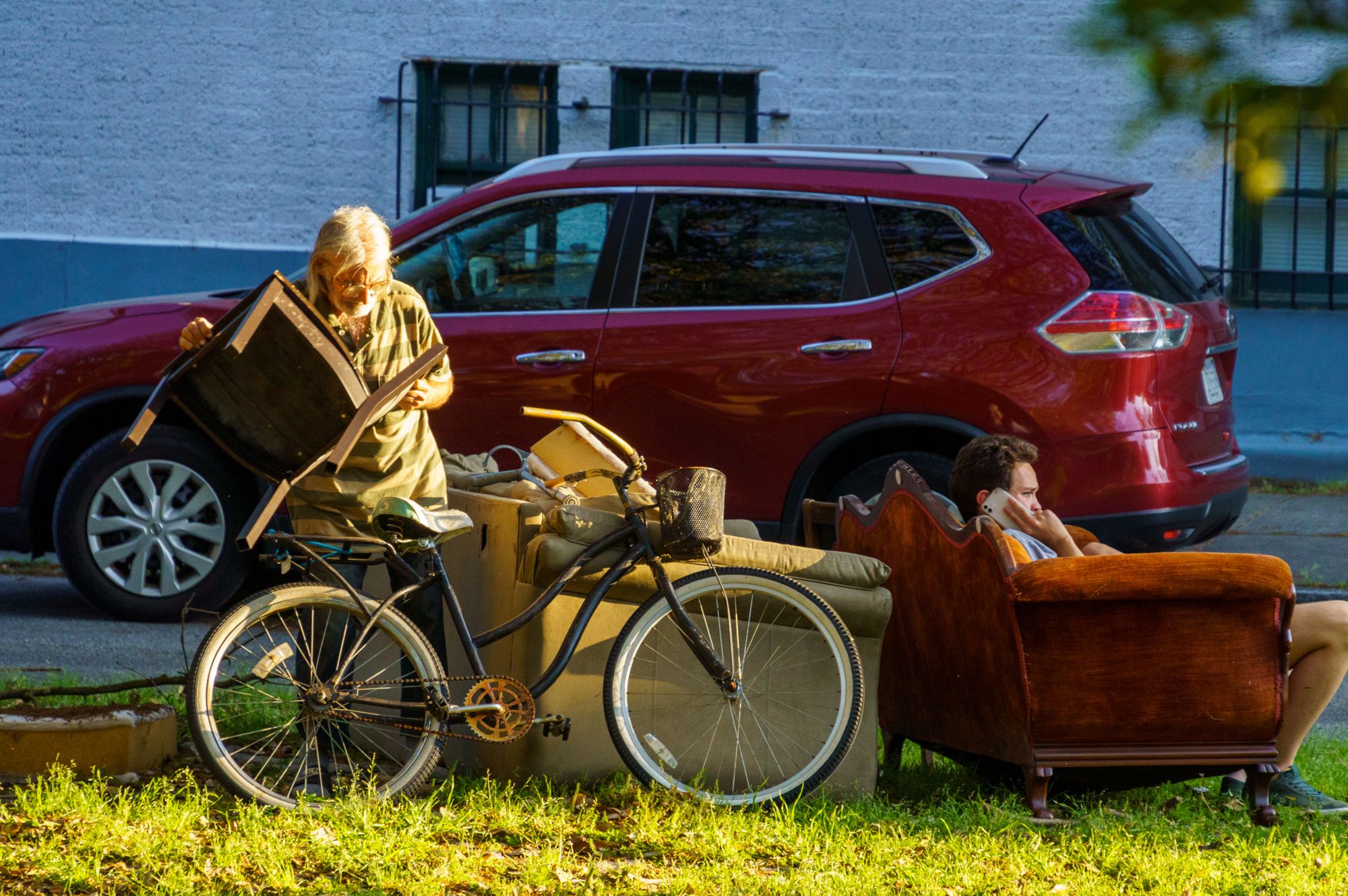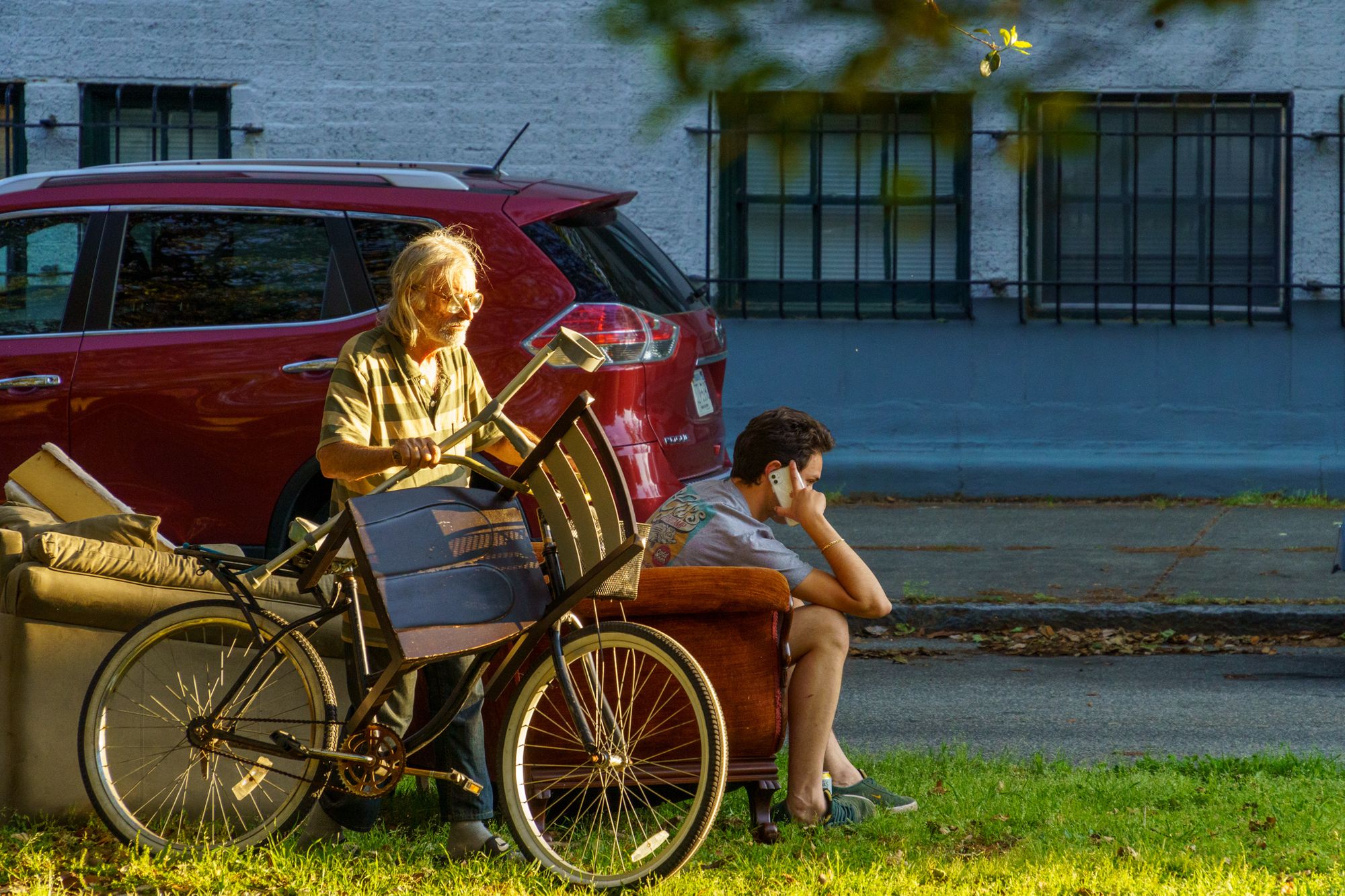Faded Glory in the Golden Hour

There are several things I'd like for you to know about these photos, the first of which is that I'd been assembling a series of images loosely organized around the coronavirus crisis – namely, visual markers of such as relates to public life. One thread of that was the accumulation of discarded furniture on my street.
Keep in mind, people discard furniture frequently in the park-like area of my street; that has nothing at all to do with the coronavirus crisis. The difference now is that the city has furloughed the workers who normally do bulk-waste collection, and thus some of what you see here has been present for at least three weeks.

I would also point out that even in normal times, the city of Norfolk does not provide any garbage collection from multi-family buildings, whether for weekly trash pickup or bulk waste collection. Multi-family buildings – apartment or condo – must always arrange at their own expense weekly trash pickup from a private contractor, and the same would also be true of bulk waste collection. (This is not an unusual arrangement amongst cities, though why that is, I'm not entirely sure, since I believe the tax rate on multi-family buildings and condo units is the same as for single-family homes.) Nonetheless, in the interest, I suppose, of neighborhood order and sanitation, the city does typically – outside of a pandemic – eventually collect the cast-offs that people toss into the median.
Frankly, it's always annoyed me whenever people make their own problems someone else's, as with discarding furniture in this way. Of course, some of it's pretty decent stuff, and some of it would best serve as sustenance for critters who'd eventually reduce it to compost.

The surprising part of the cast-offs being chunked into the green space is how often someone will collect them, either for use themselves, or to resell, or to scrap – and any of those possibilities are better than sending yet more products of consumerism and consumption to the landfill. Still, the worst of the worst will sit there until it rots or the city collects it – cases in point here would be the wooden chairs and the beige sofa.
The rust-colored sofa, however, appeared yesterday (Saturday, May 2, 2020), and as of today, there are yet more items appearing beside it.
Having said all that, I find golden hour light captivating, and the rust-colored sofa looked especially stately in the glow of yesterday evening's sunset. And then, after a young man plopped down on it, I thought it would make for a fantastic photo, though I have seldom had it in me to ask strangers if I could photograph them. And even if one does have it in them, that request in itself changes the moment. Of course, while he was there, I was eating dinner on the porch, and then he left, which rendered the point moot.

Lately, though, on many days, I've seen the younger guy walking somewhere – probably to 7-Eleven, given the time required – buying one can of some beverage or other, and then walking back, presumably, to wherever he must live. But on his first trip back yesterday, he plopped down on the sofa and then began texting someone. I thought, at first, perhaps he wanted the rust-colored sofa and was summoning a friend or roommate with a truck. No such luck, though.
But after he'd headed back in the direction from which he usually comes, he later returned, and as he passed by my building on that second occasion, he was on the phone. When he came back with another canned beverage, he once again sat on the sofa, this time to continue his call.
There's something I found charming, in a way, about a sofa that shouldn't have been there in the first place being used casually for its intended purpose, as if it were in his living room, or as if it should be where it now is.

As the younger fellow continued his call, the long-haired, older fellow appeared. He's someone whom I've seen around the neighborhood for years, usually riding a beater of a bicycle. I've generally assumed him to be homeless, but certainly do not know that to be the case. (Edit on May 4, 2020: I was kindly contacted by a friend who knows this gentleman, and I am now aware that he owns a used bookstore in the city.)
Another thing I should tell you at this point is that I tend to spend a good bit of time on my porch during nice weather, and that's been especially true during the lockdown of the coronavirus crisis. So, there I was, watching something that almost could've passed for a scene transpiring on a theatrical set, lit beautifully by golden hour sunshine.
The first thing I found interesting about the older guy's arrival was that he eased himself, seemingly without hesitation, into a space I think others might've avoided until the younger guy had vacated the rust-colored sofa. I also couldn't help but consider that a man with a brace was going to manage not only a bike, but a chair, as well. Since it initially appeared to me that the chair had metal components (but probably not, upon closer inspection of the photos), my assumption was that perhaps he was going to scrap those elements of it.

As all of this began to unfold, the younger guy casually looked back a couple of times when he realized the older man was moving closer, but largely appeared to continue on with his phone conversation as if nothing about it were unusual. Then, as the older man eventually began to leave the scene, the younger guy did turn and briefly take in the sight.
I consider myself at least reasonably observant – and certainly an observer of human nature – and I would say that a fair bit of the photography I've done falls into a documentary style, though I try to ensure there's some element of loveliness present, or an interesting twist. Obviously, in this instance, I found the tableau too interesting and full of contrasts to ignore, to the point that I wound up with a subset of photos that I felt related a story of their own, branching off from the primary concept that had led to my turning a lens toward the discarded furniture in the first place.
If the photographs make you uncomfortable, I can imagine at least a few possible reasons for that, one being the amount of waste Americans generate, as showcased here. Another, of course, would be the inequities in this society that are easy to spot, as some seemingly eke out an existence with others' cast-offs, and transform others' waste into something more useful (though that is the sort of efficiency that once seems to have been more widely lauded in U.S. society). A third reason is that I think the photos have a voyeuristic feel, similar to a gaze that lingers too long, even though all of this transpired in public, within full view of the residents of any of the scores of apartments who might've cast a glance outside, much as I observed it from my porch.

Lastly, I must say that just in the course of writing this, more furniture appeared – a large mirror, a recliner, and a table – and the mirror, recliner, and one of the case goods (a dresser, perhaps) have now been carted away, at least some of it by a young couple. And now, during the course of editing this, the recliner has returned.
So, it seems that even if perhaps not everything old is new again, at least some of it is, and the circle of life continues on.

